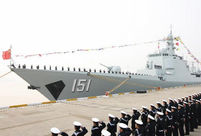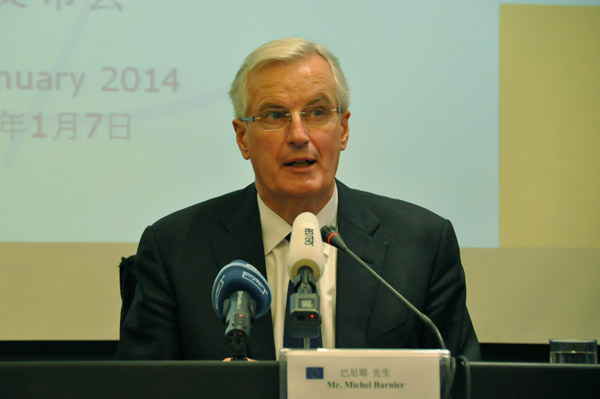BEIJING, Jan. 9 -- After 35 years of economic boom sparked by the reform and opening-up policy, China is advancing its reforms in the new year by building "a new open economic system."
The new system, brought up during the third plenum of the 18th Central Committee of the Communist Party of China (CPC) last November, aims to relax investment access and speed up the construction of free trade zones.
In order to carry out the new system put forward by the new leadership, the notion of "interconnection" is highly valued.
The Silk Road economic belt with Central Asian countries and the 21st century Maritime Silk Road with Southeast Asian countries, proposed by the new Chinese leadership, well reflected this notion of "interconnection."
The two "silk roads" are expected to deepen China's cooperation with its neighbors, and help spill over its development bonuses to other countries.
Yuri Tavrovsky, a prominent political expert from Moscow Friendship University, said China's strategy for the two "silk roads" was a logical extension of the Chinese Dream concept.
To push forward the "interconnection," China also dedicated itself to promoting regional free trade negotiations.
While regional trade cooperations are gaining momentum worldwide, China was excluded from the negotiations of the Trans-Pacific Partnership (TPP) and Transatlantic Trade and Investment Partnership (TTIP) pushed hard by the United States.
The new economic strategy adopted by Washington was dubbed "ABC" -- "Anyone But China" -- by the British newspaper Financial Times.
Chinese Commerce Minister Gao Hucheng said in an article in the People's Daily, the flagship newspaper of the CPC, that "if we responded inadequately in the forming of the new rules, we will risk being marginalized, which will bring negative effects on our external environment for development."
To meet the challenges, China has accelerated its negotiation on the China-South Korea, China-Australia and China-Japan-South Korea free trade areas (FTA) with relevant countries. Meanwhile, China also tries to achieve substantial progress in the Regional Comprehensive Economic Partnership (RCEP), a free trade agreement involving deeper engagement than the existing FTAs of the Association of Southeast Asian Nations (ASEAN).
China's resolution of economic reform comes at a time when the international economic pattern is undergoing drastic changes: emerging economies like China are rising fast and becoming important engines of global growth.
In the meantime, regional economic cooperation and the collectivization and regionalization of the world economy are becoming ever more prevailing.
While facing a changing economic situation, China's adjustment of its economic systems does not only need to emancipate the domestic productivity, but also comply with China's role in international economic systems.
By deepening its economic cooperation with foreign countries, China's economic reform aims to realize win-win cooperation with other countries.
Ryan Rutkowski, a researcher with the Washington-based Peterson Institute for International Economics, estimated that the broader change appeared to be the theme for 2014, and said he "expected more from the Shanghai FTZ pilot, and an expansion of efforts to pursue international trade and investment agreements."
According to National Bureau of Statistics, China has contributed an averaged 20 percent of the world's economic growth annually since the 2008 financial crisis.
Just as Joergen Oerstroem Moeller, visiting senior research fellow with the Institute of Southeast Asian Studies, pointed out, it is important for China to manage its own economy well, because it will boost other country's confidence that a continued and stable economic growth is achievable.
The new open economic system will not only shape the future development of the Chinese economy, but also offer inspiration and a different way of thinking for the creation of a more balanced and just international economic order.
 Chinese Consulate General in S.F. burned for arson attack
Chinese Consulate General in S.F. burned for arson attack Roar of J-15 fighter is melody for operator on the Liaoning
Roar of J-15 fighter is melody for operator on the Liaoning A 90-year-old forester's four decades
A 90-year-old forester's four decades Most touching moments in 2013
Most touching moments in 2013 2013: Joys and sorrows of world politicians
2013: Joys and sorrows of world politicians Missile destroyer Zhengzhou commissioned to Chinese navy
Missile destroyer Zhengzhou commissioned to Chinese navy China is technically ready to explore Mars
China is technically ready to explore Mars Photo story: Life changed by mobile technology
Photo story: Life changed by mobile technology Bullet train attendants' Christmas Eve
Bullet train attendants' Christmas Eve Shocking moments when PLA's weapons open fire
Shocking moments when PLA's weapons open fire Barnier: China, EU should travel side by side on the road of reform
Barnier: China, EU should travel side by side on the road of reform 'Phubbing' people seen everywhere
'Phubbing' people seen everywhere China's bun brand to buy American coffee giant
China's bun brand to buy American coffee giant Yang Mi, Hawick Lau hold wedding in Bali
Yang Mi, Hawick Lau hold wedding in Bali Snowy, milky, cheesy Fribourg of Switzerland
Snowy, milky, cheesy Fribourg of SwitzerlandDay|Week|Month